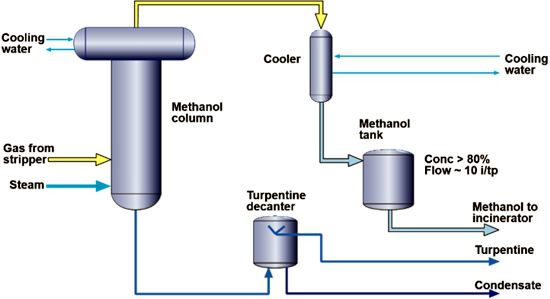Methanol - from pulp mill waste byproduct to valuable fuel
Methanol in mill condensates is considered by most pulp mills in North-America to be a waste byproduct of the pulping process that needs to be disposed, either through the effluent treatment system or by incinerating the stripper off gases (SOG), often using the lime kiln as the incineration point. Incineration of SOG in the lime kiln can cause problems in kiln operation due to the high moisture content of SOG and the variability in the amount of SOG produced, which has been linked to ring formation and capacity issues for the kiln. Most mills in Europe have instead adopted an approach where they liquify the methanol, removing a significant amount of water and making it an easier fuel to handle that can be properly combusted in a controlled manner.

Typical liquid methanol system
Recently, methanol is also being looked at as a possible green transportation fuel. While burning in the kiln does not require additional purification steps, the nitrogen and sulfur content of the methanol needs to be reduced to allow its usage as a transportation fuel.
A white paper found HERE reviews the technology that has already been used for several years to liquify methanol from the SOG and the new process that has been developed to produce purified methanol that can be sold as a green renewable fuel, transforming an undesirable waste byproduct into a potential new revenue stream for the pulp mill.
For more information on liquification of methanol from stripper off gases and producing purified methanol, contact your Valmet representative.